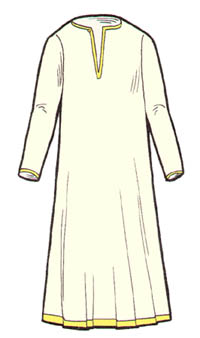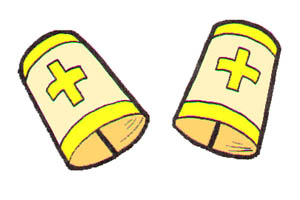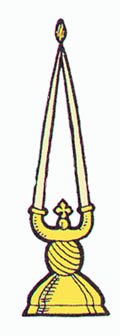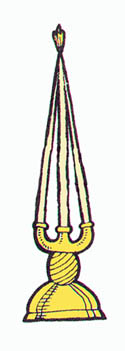Vestments
 |
In the Orthodox Church the clergy vest in special clothing for the liturgical services. There are two fundamental Christian vestments, the first of which is the baptismal robe. This robe, which is worn by bishops and priests at the service of holy communion and which should always be white, is the “robe of salvation”: the white garment in which every Christian is clothed on his day of baptism, symbolizing the new humanity of Jesus and life in the Kingdom of God (Rev 7.9ff).
The second fundamental vestment for Christian clergy is the stole or epitrachelion which goes around the neck and shoulders. It is the sign of the pastoral office and was originally made of wool to symbolize the sheep—that is, the members of the flock of Christ—for whom the pastors are responsible. Both bishops and priests wear this vestment when they are exercising their pastoral office, witnessing to the fact that the ministers of the Church live and act solely for the members of Christ’s flock.

As the Church developed through history the vestments of the clergy grew more numerous. Special cuffs for deacons, priests, and bishops were added to keep the sleeves of the vestments out of the way of the celebrants during the divine services. When putting on their cuffs, the clergy read lines from the psalms reminding them that their hands belong to God.
 |
A special belt was added as well to hold the vestments in place. When putting on the belt the clergy say psalms which remind them that it is God who “girds them with strength” to fulfill their service. Only the bishops and priests wear the liturgical belt.
All orders of the clergy wear a special outer garment. Deacons, sub-deacons, and readers wear a robe called a sticharion. It is probably the baptismal garment, decorated and made more elaborate. Deacon and sub-deacons also wear a stole called the orarion, probably originally a piece of material upon which were inscribed the liturgical litanies and prayers (orare means to pray). The deacon still holds up the orarion in a position of prayer when he intones his parts of the divine services. The sub-deacon’s orarion is placed around his back in the sign of the cross.
Priests wear their white baptismal robe over which they have their pastoral stole, cuffs and belt. They also wear a large garment called a phelonion which covers their entire body in the back and goes below their waist in front. This vestment was probably developed from the formal garments of the early Christian era and, under the inspiration of the Bible, came to be identified with the calling of the priestly life. When putting on his phelonion, the priest says the lines of Psalm 132:
Thy priests, O Lord, shall clothe themselves in righteousness, and the saints shall rejoice with joy always now and ever and unto ages of ages. Amen.
The bishops traditionally probably also wore the phelonion over which they placed the omophorion, the sign of their episcopal office as leading pastor of the local church. When the Christian empire was captured by the Turks in the fifteenth century, however, the Christian bishops of the East were given civil rule over all Christians under Turkish domination. At that time, since there was no longer a Christian empire, the bishops adopted the imperial insignia and began to dress as the Christian civil rulers used to dress. Thus, they began to wear the sakkos, the imperial robe, and the mitre, the imperial crown. They also began to stand upon the orlets (the eagle) during the divine services and to carry the staff which symbolized more their secular power than their pastoral office. At that time as well, the word despota (vladyko or master)—a title for temporal rather than spiritual power—was used in addressing the bishops, and the clergy began to grow long hair which was also a sign of earthly rule in former times. In the seventeenth century, during the reform of Patriarch Nikon, the Russian Church adopted these same forms for its bishops.
In the Church some of these new insignia were “spiritualized” and given a Biblical meaning. Thus, the mitres became signs of Christian victory, for the saints receive their crowns and reign with Christ (Rev 4.4). The eagle became the sign of the flight to the heavenly Jerusalem since it is the classical Biblical symbol of Saint John and the fourth gospel (Rev 4.7; Ezek 1.10). The staff became the symbol of Aaron’s rod (Ex 4.2), and so on. It should be understood, however, that these particular insignia of the bishop’s office are of later and more accidental development in the Church.
 |
In relation to the bishop’s service in the Orthodox Church, the use of two special candelabra with which the bishop blesses the faithful also developed. One of these candelabra holds three candles (trikiri - on right) while the other holds two candles (dikiri - on left). These candelabra stand for the two fundamental mysteries of the Orthodox faith: that the Godhead is three Divine Persons; and that Jesus Christ, the Saviour, has two natures, being both perfect God and perfect man. |  |
Bishops and priests in the Orthodox Church also wear other special garments. There are, first of all, two pieces of cloth: one square (nabedrennik) and one diamond-shaped (epigonation or palitsa). The former is worn only by priests as a sign of distinction, while the latter is always worn by bishops and is given to some priests as a special distinction of service. Probably these cloths were originally “liturgical towels.” Their symbolical meaning is that of spiritual strength: the sword of faith and the Word of God. They hang at the sides of their wearers during divine services.
There are also clerical hats which carry special meaning in some Orthodox Churches—the pointed hat (skufya) and the cylindrical one (kamilavka). The kamilavka is normally worn by all Greek priests, but only by some clergy in other national Orthodox churches as a special distinction. The kamilavka may be black or purple; monks, and by extansion all bishops, wear it with a black veil. The skufya is worn by monks and, in the Russian tradition, by some of the married clergy as a special distinction, in which case the hat is usually purple. Also in the Russian tradition certain married clergy are given the honor of wearing a mitre during liturgical services. In other Orthodox churches the mitre is reserved only for bishops and abbots of monasteries (archimandrites). Generally speaking, especially in the West, the use of clerical headwear is declining in the Orthodox Church.
Finally, it must be mentioned that bishops and priests wear the cross. The bishops also wear the image of Mary and the Child (panagia—the “all holy”). In the Russian tradition all priests wear the cross. In other churches it is worn liturgically only by those priests given the special right to do so as a sign of distinction.
As the various details of clerical vestments evolved through history, they became very complex and even somewhat exaggerated. The general trend in the Church today is toward simplification. We can almost certainly look forward to a continual evolution in Church vestments which will lead the Church to practices more in line with the original Christian biblical and sacramental inspiration.
The Orthodox Church is quite firm in its insistence that liturgical vesting is essential to normal liturgical worship, experienced as the realization of communion with the glorious Kingdom of God, a Kingdom which is yet to come but which is also already with us in the mystery of Christ’s Church.
